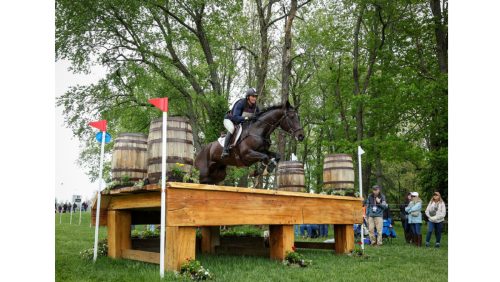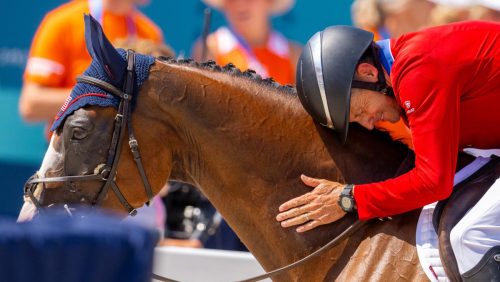At last January’s U.S. Equestrian Federation convention in Lexington, Ky., President David O’Connor said that he’d like instructor-certification programs for all equestrian disciplines to be established in the next five years.
“The dressage program has gone up and down but is now popular. The eventing program is new, but people are going for it. A lot of people don’t think that they need to be certified because they already have plenty of business, but I find that a little shortsighted,” said O’Connor.
The U.S. Dressage Federation established its instructor-certification program in 1990, one that was met with considerable initial resistance and is only now hitting its stride. The U.S. Eventing Association has a newer program, started in 2002, that’s really taking off.
Some 52 instructors, at four levels, have already passed their certification exams, and another 10 were assessed in late July. The certified instructors live in eight of the 10 USEA areas; areas III and VII don’t yet have any certified instructors.
The year-old U.S. Hunter/Jumper Association is already forming committees aimed at helping an ICP program take form. And even the American Endu-rance Ride Conference has a mentoring program underway for its generally self-instructed members.
About half a dozen other organizations already have instructor-certification programs, but they aren’t affiliated with any national or discipline-specific organizations. The USDF’s leaders were the first to establish a discipline-affiliated instructor-certification program in the United States, modeled after the German and British systems.
Becoming a USDF-certified instructor involves an intense five-part exam over a two- to three-day period, including riding, longeing horse and rider, teaching, an oral exam on classical training theory, and a written test that covers stable management, nutrition and basic veterinary care.
The USEA’s program has similar requirements. Sue Hershey, who along with Karen O’Connor is co-chairman of the USEA program, explained, “About nine workshops and three or four assessments are held every year. You have to go to a workshop or workshop pair (dressage and jumping) before you can be assessed, but quite a few more people go to the workshops than choose to get assessed. The point is to educate, so that’s fine.”
Hershey taught high school courses for 30 years but has never been a professional riding instructor. She competes as an amateur. “That allows me to look at the ICP with a fresh point of view, because I know education not just in the horse world,” she said.
Don Sachey, of Santa Barbara, Calif., is a professional instructor who rode on the gold-medal U.S. team at the 1974 World Championships. As an ICP faculty member and assessor, he’s been instrumental in organizing the program.
“It’s quite intense, and a little uncomfortable, for people to stand in front of their peers, teach a lesson, and be evaluated. I give a lot of credit to those people who put themselves out there,” he said.
“A bond is established between the partici-pants that later carries into the warm-up ring: people are really working together,” he continued. “If one instructor can’t go to an event, they may call each other to warm up their students. A lot of things come and go, but I think that this particular thing is here to stay.”
Involving Elite Riders
Getting any sport’s top riders involved in a program is essential to its success. Not only will it inspire up-and-coming instructors to make the step toward certification, but also it will make it seem more worthwhile. Even though he won the 2000 Olympic gold medal, David O’Connor was one of the first people to achieve certification in the USEA’s program.
“I do think the fact that the ICP Committee included people successful in our competitions has contributed to how fast the program has gotten going; all are serious about what they do, and they all care about being better instructors,” said Hershey. “None of them thinks that they’re ‘good enough’–they’re always learning and finding better ways to do things.”
Brian Sabo, of Newport Beach, Calif., is also a faculty member and an assessor.
“Organizations tend to be isolated from the mainstream in promoting their own agenda. They have the potential to lose touch outside their own little environment,” he said. “The ICP is attempting to reach out to the elite riders to promote proper teaching at the grassroots level so there is a seamless connection across the levels.”
ADVERTISEMENT
Sabo now only teaches at barns where instructors are ICP-certified. “I teach monthly clinics all over the West Coast, and I train them and their students, and they watch me train their students. In the end, I’ll leave a group of students who have a system. I hope that all of the older trainers realize what a benefit they can be,” he said. “We all need to see the bigger picture.”
Sabo, 50, has been involved in the U.S. Pony Club since he was 8. He noted that accomplished instructors often don’t have the time or the inclination to teach a group of D-1 Pony Clubbers how to trot rails on the ground, but “if you send a 21-year-old who’s young and excited, she’ll do a great job.”
That’s why the USEA’s leaders are developing a partnership with the U.S. Pony Clubs to encourage higher-rated members who want to be professionals. The two groups’ leaders are trying to create an outreach program that will enable H-A and A candidates to get involved in the ICP.
It’s not a surprise to Sabo that his West Coast cohorts have been quick to adopt the instructor-certification concept.
“In the general sense, the West Coast has always been an early adaptor,” he said. “They’re always heavily involved in the education process out here. We don’t have as many elite riders out here, but we’re developing a progressive outreach program to bring people out to teach.”
Hershey explained that they didn’t just pull their program out of the sky. They carefully examined the programs in Germany, Australia, and Canada.
“Among other sources, the ICP is based upon the German federation’s dressage training scale and upon jumping principles described in print by knowledgeable instructors like Blyth Tait and Jim Wofford,” said Hershey. “The Canadians have a good system also–most other countries do, frankly. And I compliment the U.S. Pony Club–based on the British Pony Club but developed as a system in and for the United States. Pony Club is way ahead, really, with three manuals and a rating system.”
Across The Disciplines
Most endurance riders are “rugged individualists” who taught themselves to go down the trail. But now newcomers can get advice from more experienced riders.
Stagg Newman, of Asheville, N.C., president of the American Endurance Ride Conference, is one of the country’s most experienced international competitors, and he mentors several riders, by e-mail.
“Very few people in endurance even claim to be instructors,” Newman said. “It’s different from the show world. Riders are usually on their own horse and have their own program. We have several ways of educating members: through our publication, our website, and in person through clinics. And then we have the mentor program.”
Newman, who’s all for promoting education, said that regulating instruction and mandating certification for instructors would probably meet with resistance.
“The history of our sport goes back to minimal rules, with the rider caring for his own horse,” he said. “There is a good history of sharing information in our sport–sort of like marathon runners, there is a feeling that we’re all in this together. You put yourself out there as a mentor, and it’s sort of by word of mouth who’s a good mentor and who’s not.
“Rating them is the question,” he added. “There are people who have ridden 10,000 miles who you wouldn’t want to mentor anyone.”
That’s why, explained David O’Connor, “We want the different organizations to develop in their own way with their own programs. As it is, everybody has the ability to take anyone’s safety into his or her own hands. That makes the insurance aspect huge; any time you have something more dependable in a court of law, it’s easier to insure.”
Bill Moroney, the USHJA president, noted, “There is considerable reason for people to get certified. For instance, they might get 10 to 15 percent off their liability insurance.
“Certification would add legitimacy to what we do. There’s no ‘I graduated from Yale as a riding instructor.’ You can find out if someone has an MBA or not, and in a few years you will be able to find out if a riding instructor is qualified too,” he added.
ADVERTISEMENT
Hershey believes that the success of any instructor-certification program lies in “convincing people that this is a good thing for them.
“The hunter/jumper people know the most about their own group of people, and they need to consider them as they develop their program. I think that they can definitely develop something in the next five years. Where there’s a will, there’s a way.”
Like A Retreat
Education is, of course, the whole point of the U.S. Eventing Association’s instructor-certification program.
“The great thing about the ICP is that when you get eight candidate instructors to one faculty member and the candidate instructors practice teach in front of each other, each candidate watches and listens to the practice teaching of all the other candidates,” said Sue Hershey, the program’s co-chairman.
“Therefore, much more content is covered than if only one candidate were with the faculty member.”
At workshops, said Hershey, candidates often “sit down at a meal together, excited to talk about the principles of teaching. It’s almost as though they were on a retreat–there are no students to distract them, and they can do things together, like go out and test the best way to teach shoulder-in.
“There is a natural enthusiasm; they’re engaged with each other. It’s a beautiful side effect of bringing people together to explore what they care about. When they leave a workshop, instructors are stimulated and reading and thinking and they communicate with their students more than ever before.”
Promising Partnership
Peggy Entrekin, executive director of the U.S. Pony Clubs, sees great potential in the developing partnership between the youth group and the U.S. Eventing Associ-ation’s instructor-certification program.
“In my experience teaching and training back and forth across the country, I have found a huge inconsistency in how people teach,” she said. “It helps young instructors not to have to recreate the wheel generation after generation, and it provides a consistent way to promote training to the elite level.”
Entrekin said that a national train-ing center like they have in Germany wouldn’t work as well in the United States because the country is so much larger and because Americans tend to be more independently minded about their own education.
“But there is an efficient, safe way to instruct,” she said. “Those of us trainers who have been doing this for 30 or 40 years can pass on what we’ve learned to our students.”
Brain Trust
Brian Sabo, one of the U.S. Eventing Association’s instructor-certification program’s faculty members, admitted that they’ve faced some resistance from experienced trainers, who feared the program would try to change their teaching methods. But, he said, that isn’t the program’s goal.
“It’s like a brain trust,” Sabo ob-served. “Often, when the older trainers pass on, their information goes with them. How many more trainers does the average instructor create? Instead of isolating information we should share it–we’ll have better instruction, happier horses and safer riders.”














